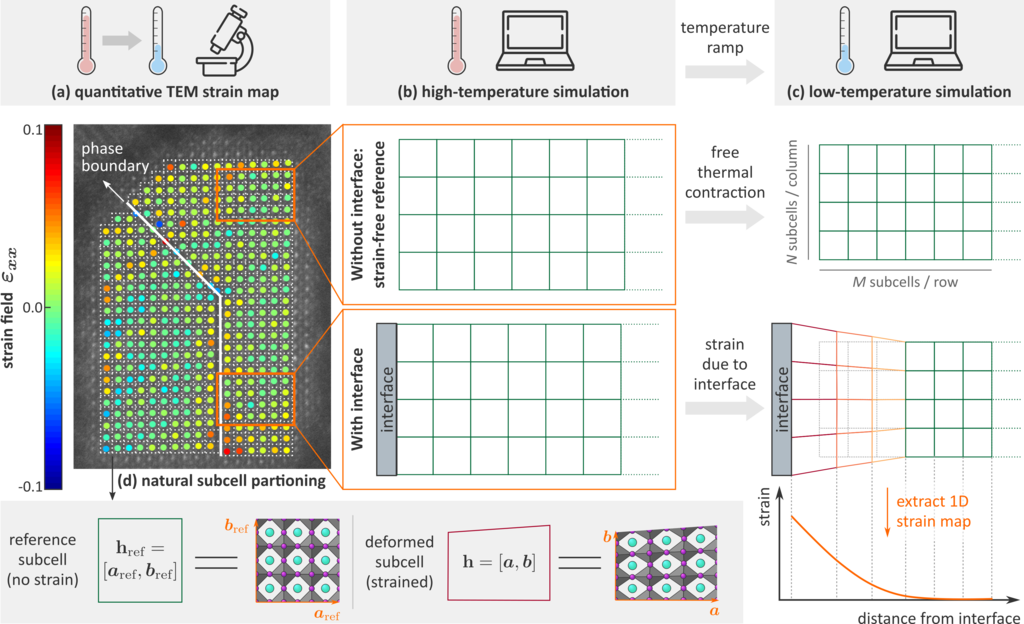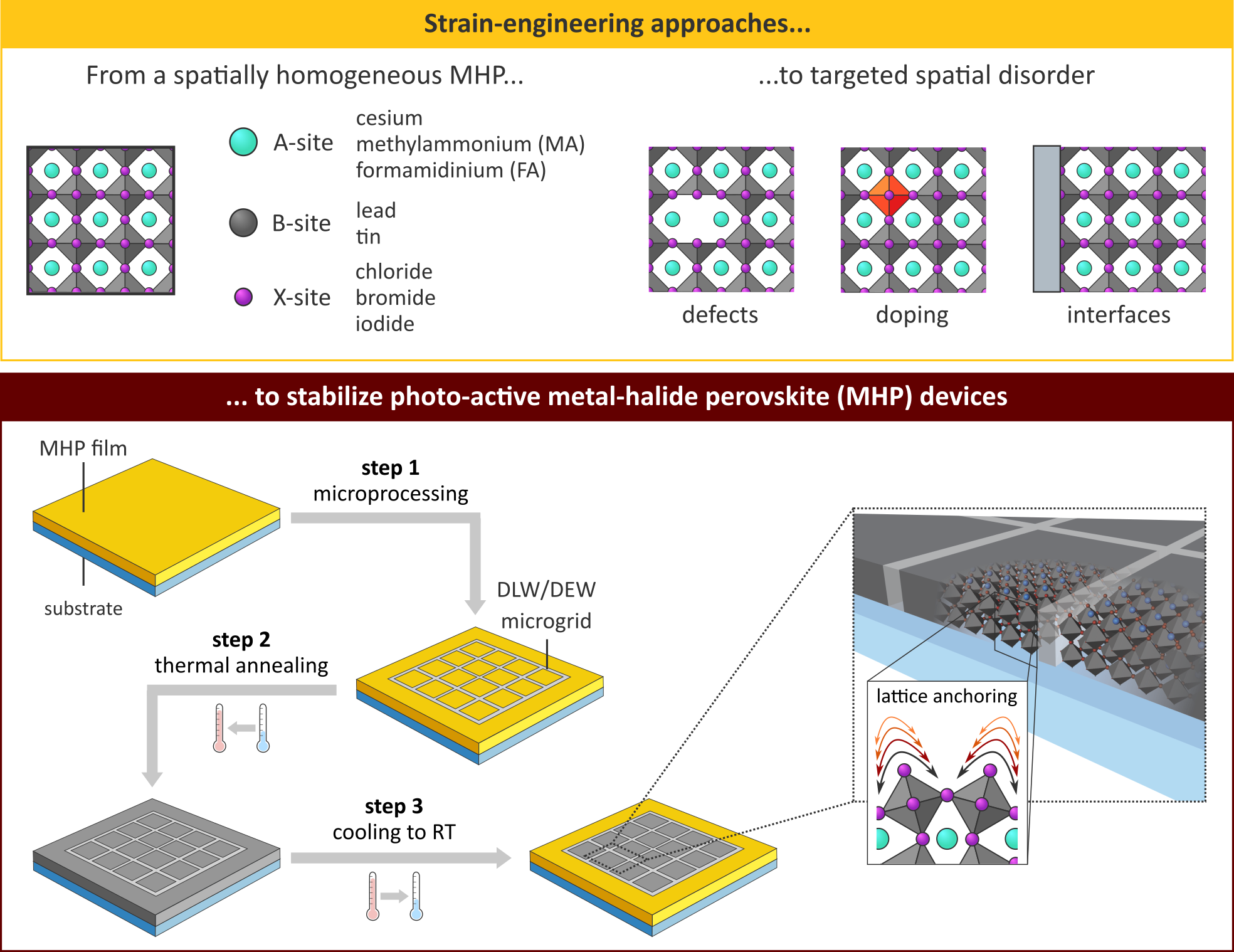Strain engineering metal halide perovskites: How spatial disorder impacts the stability of photo-active devices
Strain engineering metal halide perovskites: How spatial disorder impacts the stability of photo-active devices
Promotor(en): V. Van Speybroeck, S.M.J. Rogge /28113 / Model and software developmentBackground and problem
Identifying materials and devices that efficiently convert light into electrical current and vice versa is one of the most important challenges for today’s society, with applications ranging from solar panels to medical scanners. Metal halide perovskites (MHPs, see Figure 1) are a very attractive class of photoactive materials that can be easily processed and boast very high conversion efficiencies of more than 25%.1 However, the main fundamental roadblock to commercialize these materials lies in their phase transformation from their photoactive black phases to an undesired yellow phase, which, unfortunately, occurs spontaneously under ambient conditions. Current MHP research therefore focusses on approaches to suppress this spontaneous phase transition and retain the desired black phase also at room temperature and when exposed to air. In this respect, we recently proposed, together with experimental collaborators from the KU Leuven and the University of Antwerp, to control the polymorphism in MHPs through so-called strain engineering.2

Figure 1: Typical structure of the black phase of a metal halide perovskite (MHP), with indication of the different atoms present in the material. Various types of spatial disorder can be introduced to stabilize the MHP’s black phase and design strain-engineered photo-active devices.
Strain engineering is a concept in which a material is forced to deviate from its equilibrium structure due to the targeted inclusion of spatial disorder such as defects, doping, or interfaces. These types of disorder deform the material, resulting in strain fields that can propagate and nucleate throughout the material. In turn, these strain fields can stabilize the desired black phase. For instance, as indicated in Figure 1, creating a microgrid in a MHP device and heating the device to obtain the desired black phase, results in a material that retains its black phase even when cooling the material back to room temperature. This effect is caused by the strain induced by this microgrid, which suppresses the phase transition. Essential in this respect is to understand which types of disorder are best suited to create these polymorphism-altering strain fields and to which extent they range through the material.
Goal
In this thesis, we aim to systematically investigate how different types of disorder give raise to strain fields using molecular modeling, starting with the prototypical CsPbI3 material. In a first task of the thesis, local disorder will be introduced, either through vacancies of the A-, B- or X-sites in CsPbI3, or by replacing specific atoms through doping. Via dynamic molecular simulations, the positions of each of the atoms in the disordered materials will be followed under realistic temperature and pressure conditions, from which the resulting strain field can be extracted (see Figure 2). The main focus of this part of the thesis is to investigate the spatial extent of the created strain fields and to understand how different strain fields, originating by the simultaneous introduction of different types of spatial disorder, interact with one another.

Figure 2: Procedure to define strain fields from a molecular simulation based on the deformation of a structure in response to spatial disorder. The resulting strain fields can be directly compared with strain maps extracted using transmission electron microscopy.
In the second part of the thesis, the simulation models will be scaled up, from the nanoscale to the microscale. In this way, it will be possible to also model larger types of spatial disorder, such as interfaces or larger (meso)pores. However, given that the size of these simulation models prohibits the use of density-functional theory (DFT) simulations adopted in the first part of the thesis, we will rely in this part on in-house derived machine-learning potentials. These machine-learning potentials are fitted to the DFT data, and are already available for some of the materials of interest here. The student will be actively coached to make him/her acquainted with the advanced simulation techniques early in the thesis year, and to transfer necessary programming skills needed to perform the research. These larger models will allow us to fully probe how different types of spatial disorder interact with one another through strain fields. In turn, this will help us to understand how these strain fields alter the polymorphism in MHPs. As a result, this thesis aims to define strain-engineering design principles for photo-active MHP devices that can then be put to test by our experimental collaborators.
- Study programmeMaster of Science in Engineering Physics [EMPHYS], Master of Science in Physics and Astronomy [CMFYST]KeywordsPhoto-active devices, strain fields, metal-halide perovskites, design principles, machine-learning potentials, energy conversionReferences
1R. Wang, T. Huang, J. Xue, J. Tong, K. Zhu, Y. Yang, Nat. Photo. 15: 411, 2021.
2J.A. Steele, H. Jin, I. Dovgaliuk, R.F. Berger, T. Braeckevelt, H. Yuan, C. Martin, E. Solano, K. Lejaeghere, S.M.J. Rogge, C. Notebaert, W. Vandezande, K.P.F. Janssen, B. Goderis, E. Debroye, Y.-K. Wang, Y. Dong, D. Ma, M. Saidaminov, H. Tan, Z. Lu, V. Dyadkin, D. Chernyshov, V. Van Speybroeck, E.H. Sargent, J. Hofkens, M.B.J. Roeffaers, Science 365: 679, 2019.
